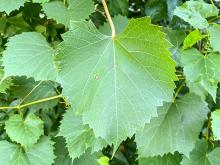Trees, Shrubs and Woody Vines
Media

Species Types
Scientific Name
Vitis species
Description
Eight species of grapes in the genus Vitis are native or naturalized in Missouri. All bear edible fruits. Like their relatives elsewhere, they have important connections to humans and to nature.
Media

Species Types
Scientific Name
Rosa multiflora
Description
Starting more than a century ago, this nonnative rose was planted across America — for many good reasons — but multiflora rose has proven to be invasive, and now the goal is to stop its spread.
Media

Species Types
Scientific Name
Rosa setigera
Description
Also called climbing rose, prairie rose is most common near woodlands, where it climbs and trails on neighboring shrubs and small trees.
Media

Species Types
Scientific Name
Carya spp.
Description
Hickories are an important part of Missouri’s oak-hickory woodlands and forests. They have tremendous economic value, too. Learn about the nine species of hickory found in Missouri.
Media

Species Types
Scientific Name
Quercus spp.
Description
Oaks are the most important group of trees in Missouri, in both human and ecosystem value. They dominate most of the forests, woodlands, and savannas in the state. Learn more about our 22 species.
Media

Species Types
Scientific Name
Symphoricarpos orbiculatus
Description
Buckbrush, or coralberry, grows throughout Missouri. This familiar thicket-forming shrub bears dense clusters of pinkish-red berries that persist through most of the winter.
Media

Species Types
Scientific Name
Fraxinus pennsylvanica
Description
Green ash is one of the most widely planted shade trees around homes and along streets. In the wild, it lives along streams and in low grounds. Sadly, it is one of the trees most vulnerable to the emerald ash borer, an exotic invasive pest.
Media

Species Types
Scientific Name
Fraxinus americana
Description
White ash leaves turn shades of yellow and purple in fall, and that is one reason it has been a popular landscaping tree. Many birds and mammals feed on the paddle-shaped seeds.
Media

Species Types
Scientific Name
Juglans nigra
Description
Easily Missouri’s most valuable tree, the black walnut provides the finest wood in the world, as well as delicious nuts. Both are in high demand and thus form an important part of Missouri’s economy.
Media

Species Types
Scientific Name
Rhus glabra
Description
Colonies of smooth sumac are most noticeable in early autumn, because the leaves turn brilliant red! You can make drinks and jellies from the clusters of fuzzy red berries.
See Also
About Trees, Shrubs and Woody Vines in Missouri
There are no sharp dividing lines between trees, shrubs, and woody vines, or even between woody and nonwoody plants. “Wood” is a type of tissue made of cellulose and lignin that many plants develop as they mature — whether they are “woody” or not. Trees are woody plants over 13 feet tall with a single trunk. Shrubs are less than 13 feet tall, with multiple stems. Vines require support or else sprawl over the ground.





















